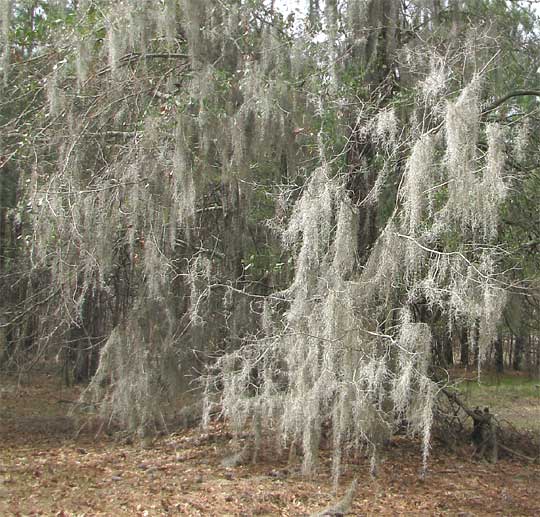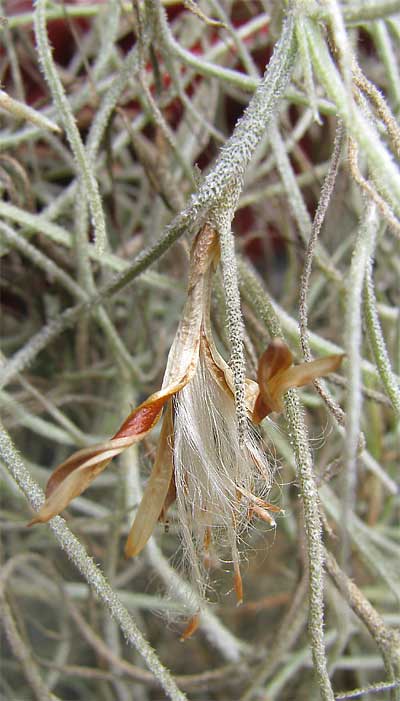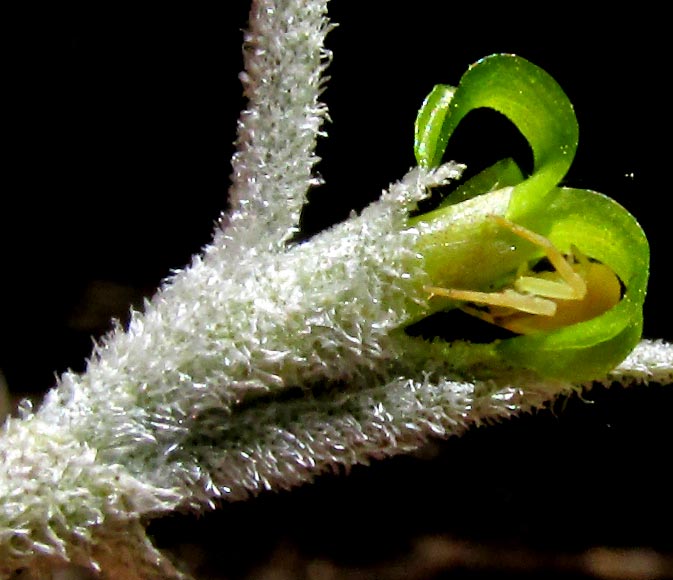Excerpts from Jim Conrad's
Naturalist Newsletter
from the March 2, 2009 Newsletter, issued from the forest near Natchez, Mississippi; elevation ~400ft (120m), ~N31.47°, ~W91.29°:
SPANISH MOSS DISPERSING SEEDS
In our upland forests often you can go for a long time without seeing Spanish Moss, TILLANDSIA USNEOIDES. I think that's because our oak/pine forests have been logged frequently by clearcutting, or cutting ALL the trees, and when that happens sunlight and drying air currents keep Spanish Moss from reestablishing on the new generation of trees. In contrast, along area highways where loggers have left a few trees to get old, Spanish Moss is common, sometimes abundant. You can see a Spanish Moss-mantled tree in the refuge below:

Spanish Moss isn't moss at all. Mosses reproduce with spores and have no flowers, fruits or seeds. Spanish Moss is a member of the Pineapple or Bromelia Family, the Bromeliaceae, which we saw a lot of in Mexico. As such, Spanish Moss produces flowers, fruits and seeds, though most people who live around it all their lives never notice any of it. You can see fuzz-footed seeds being released from a three-celled capsular fruit below:

In that picture the seeds are the tan colored, rice-grain-like little items dangling from white stalks emerging from a dense cluster of white hairs. The seeds may remind you of Dandelion seeds (which actually are fruits) with their white parachutes. The big difference is that Dandelion fruits bear their parachutes atop them, while here the parachutes arise at the base of the stalk atop which the seeds grow. The whole fruit is a bit less than an inch long.
I have to tell you about that genus name, Tillandsia. Linnaeus established that name in honor of Elias Tillands who, my old Grays Manual tells me, "as a student crossing directly from Stockholm, was so seasick that he returned to Stockholm by walking more than 1000 miles around the head of the Gulf of Bothnia." It's thought that the joke was that since this new group of epiphytic, North American plants obviously hated water, they should be named after Tillands who was famous for his hydrophobia.
entry from field notes dated April 14, 2022, taken in disturbed/reforesting borderline cloudforest within 1km of Valle de los Fantasmas, elevation ±2,320m (7600 ft), with limestone bedrock; about 40kms (24 miles), straight-line, ESE of San Luis Potosí, San Luis Potosí state, MÉXICO, (N22.06°, W100.62°)
FLOWERING SPANISH MOSS IN MEXICO

About 25 years ago the mountains in this area were mostly deforested, but now trees have been planted in some areas, mostly Mexican Cedar (Cupressus lusitanica), and other species are "volunteering," slowly reverting the land to a state, in some places, where erosion isn't completely out of control. One of the returning species is the Spanish Moss shown at the right.
It's the same Spanish Moss we had back in Mississippi, Tillandsia usneoides, which isn't surprising, since the species occurs south through Mexico and Central America, as well as the Caribbean area, deep into South America.
Now at the end of the long dry season, with the first rains expected next month, with clouds full of moisture moving through these valleys, the Spanish Moss is flowering. When the rains come, parachuted Spanish Moss seeds should be ready to germinate wherever the winds have blown them. Below you can see a flower with its distinctive yellow-green corolla:

Spanish Moss is a member of the Bromeliad or Pineapple Family, the Bromeliaceae, whose members are monocots, like grasses, lilies and orchids. As such the corolla lobes number 3, not the usual 4 or 5 of dicots. In the picture, the cellophane-like cylinder from which the corolla emerges is the calyx. The white-hairy items from which the calyx and corolla arise are modified and regular leaves. The cream-colored item sheltering below the corolla's lower lobe is a critter, maybe a mite or a spider I didn't know was there until the image was on the computer screen.
It's good seeing diverse lifeforms returning to some places in this ravaged landscape. If you ask, "Of what good is Spanish Moss," I'd say that it's good that the critter has its little niche where it can be itself, and that's good enough.
from the December 15, 2002 Newsletter, issued from near Natchez, Mississippi:
SPANISH MOSS
Books say that Spanish Moss spreads when its seeds lodge in tree bark, plus birds and wind carry moss fragments to new locations, and then those fragments develop into entirely new plants. From what I've seen, wind distribution of Spanish Moss fragments is by far the species' main means of propagation.
Regularly I am called upon to climb onto the roof of the beautiful little chapel here at Laurel Hill, to clean out the gutters. Often more Spanish Moss clogs the gutters than leaves, despite the roof being above most of the nearby moss-covered trees. In fact, I have sat atop the chapel watching rising wind currents drop pieces of Spanish Moss into the gutters, and the currents weren't really all that strong. A typical moss fragment would be about two inches long. One would think that such large pieces would require a strong wind to be carried aloft, but when Spanish Moss is dry, it's astonishingly light.
Our species of Spanish Moss ranges all through the Americas from here to Argentina. In many countries I have seen it growing on electrical wires. This shows that Spanish Moss does not parasitize the trees they live on. They take all their moisture and nutrients from the rain, the wind, and whatever non-living debris may reside on whatever they are growing upon.
Usually trees are not hurt at all by the presence of Spanish Moss. However, here on the plantation for some reason they just overwhelm the big Crepe Myrtles, keeping sunlight from entering the tree's interiors, and blocking breezes. The Crepe Myrtles don't seem to die because of this, but they do look a bit scraggly. I think that sometimes when there's a combination of the moss being wet and heavy, and a stiff wind coming along, the host branch may snap.